Don't wanna be here? Send us removal request.
Text
Unit 7 - Practice Production: Post Mortem
In this unit, we took our game through the Beta and Gold milestones, moving on from the Alpha that ended the last unit. We learnt more about the workflow of game development by experiencing it firsthand, as well as getting an understanding of crunch in real life. But in comparison to other units, the amount that I learnt this unit was actually very little, since it simply built on the previous ones.

(Above) The new main menu screen for Wave RiderZ
Building on from the previous unit, I think my management of my group members became a lot better, as I tried to make sure I knew what was going on with them at all times. I got a lot better with the scoping process and general collaboration with my teammates. When it came to putting everything together, and making sure there was collaboration between disciplines to fix everything, I think I did mostly well. There were a few art assets that were sitting on the Google Drive that hadn’t been implemented, due to me not being 100% up to date on what was implemented. For what was finished though, I think I was very on top of.

(Above and Below) A wave transition was added to break up the time between rounds, as well as a screen saying which player is in the plane

Getting to finally mesh the different pieces of the project together and see everything come together was a real treat. Moving from each milestone and getting to see the progression of the game as new mechanics and art assets were implemented made the process worth the troubles we went through. I was very proud of our end product, and I think that it stayed very close to our original vision for the game, which I owe mostly to my artists and programmers, who really helped pull through and make sure everything worked.

(Above) A brief shot of some of the particles ingame, such as the beachbomb exploding, the players taking damage, and the wake the players leave as they move
The testing process for this was also quite enjoyable. There were a few issues throughout development that the team was fully aware of, such as needing to improve the game speed and obstacle amounts, and those issues were the ones most frequently brought up by playtesters. This was great for us, because it meant that we, the developers, were on the same page as the players on what needed to be fixed, so there wasn’t anything unexpected that we didn’t know about.

(Above) One thing that people did complain about was game clarity, so the colours on the player models were lightened, and more information was given to the players before they started the round
Like I said before, I wasn’t fully on top of what assets were implemented, which I put down to a lack of communication between my other designer and I. I knew what assets were finished, but there were times where I wasn’t communicating that to him, so it wasn’t implemented.
Keeping the project from breaking in this unit was hard as well, as I faced problems with said designer on a few occasions with his commits and updates that ultimately resulted in a broken repo. The programmers managed to fix those issues, but making sure that they didn’t happen again was a struggle. We eventually worked through those problems, and the other designer didn’t cause any more.
And now that I have this unit as experience, I know that my work as a producer needs to improve. Like I said with the last unit, I felt that I was much better at managing other people and their work than I was at managing myself, and it wasn’t until one of my programmers pointed that out to me that it really sunk in. I think the problem, and thus what I should fix, was that I offloaded a lot of the designer duties onto the other designer in my group, while leaving very little for me. This resulted in periods of me feeling like I didn’t know what I was doing, so I didn’t work as effectively.

(Above) A screenshot of the Ui early in the Gold stage, which hadn’t been properly tweaked until I started doing it, which I should have done earlier in the project
Speaking of, I also need to get better at actively working every day. Some of the book keeping and documentation had holes or inconsistencies from the days that I ended up not working on them, so I need to make sure to stay up to date with that.
But in the end, I am so proud of this project, and of my team. I think that I, as a member of the group and as the producer, didn’t put in as much effort as I should have, but I think that the rest of the team did an excellent job.

(Above) The game screenshot used for the title art, taken from a different camera angle
0 notes
Text
Firewatch: A Story To Tell
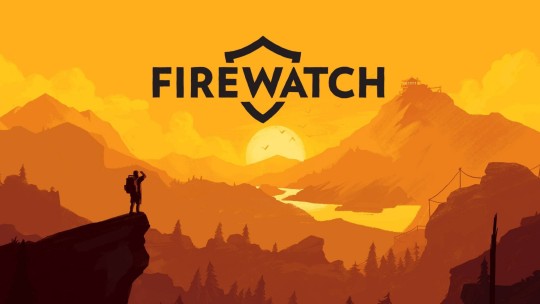
Publisher: Campo Santo
Year of release: 2016
Many of the events in Henry’s (The main protagonist) life occur offscreen, and aren’t conveyed in the actual playing of the narrative. His marriage, his getting a dog, the development of early onset dementia in his wife, all of them happen in textboxes at the beginning of the game. The details are necessary to know, so they are told to the player, but they do not need to be shown. The player can make minute decisions during the introduction which have no real impact on the story, but change small details of the world Henry lives in, such as the sketch that Julia draws in Henry’s book changing depending on whether he asks to be drawn like a Victoria’s Secret model or He-Man.
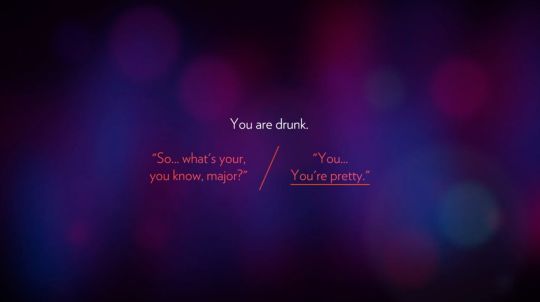
(Above) A screenshot from the opening where the player’s choice doesn’t matter, since the overall narrative plays out the same, but it allows for a more dynamic story
A lot of the little details that do into Henry’s animations are also really fascinating and noteworthy. When Henry exits the tower for the first time in game to go do his job, we see him purposefully duck under a low ceiling, as would be expected of someone in a space for their first time, but we never see it again afterwards. When the player is standing idle, you can also see him fidgeting with his ring when he is sitting down. It’s the little details that make Henry feel so alive that helps make his story, and thus the game, all the more interesting.
A good chunk of the game’s UI is also diegetic, with the map you use being a physical map that Henry holds in his hands, as well as the compass that you can use to get your bearings. This was not necessarily a unique idea, but the way that it seamlessly fit into the game’s setting and overall tone was magnificent.
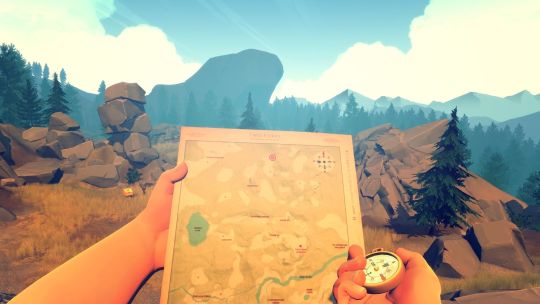
(Above) The game’s map and compass
When I played Firewatch, I loved it. The game world was vast and beautiful, and I only found myself getting lost once or twice. Talking to Delilah about all of the details in the valley really helped me get immersed into the rich environment that I was surrounded by. I think that the world being so beautiful also came from how fun it was to explore. Going from place to place via absailing or just walking, finding your own way there using the map and seeing the gorgeous landscapes along the way meant that the journey was just as important as the destination, and always as exciting.
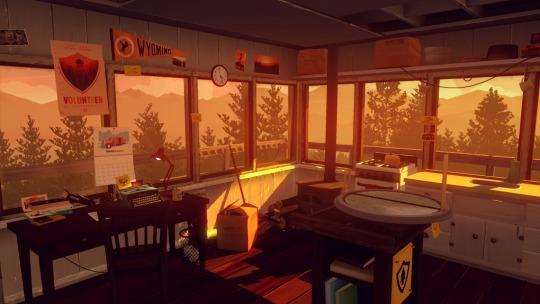
The way it told its storytelling was also incredibly fulfilling to me. Since I want to work in narrative based games later in life, seeing the way that Firewatch naturally unravels its story to the player, while cutting out all of the extra days and letting things happen and develop without player interaction was really interesting, and a great thing to learn from. Plus, the story allows for differences in dialogue where a particular answer in one conversation can affect a later conversation, which is always a big plus for making unique stories for different players.
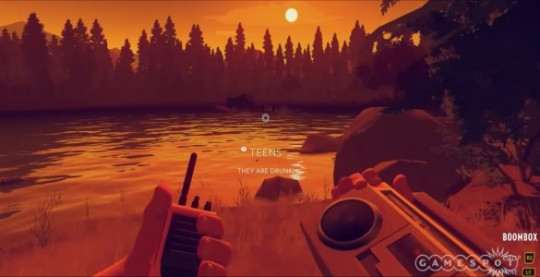
Audience response was very positive. Reviewers often cited the game’s writing and humor as the game’s strongest points, with its heavy focus on the narrative really sparking emotion within them. Online lets plays racked up about 15 million total views in the first month, across YouTubers and streamers like Markiplier and JackSepticEye, who helped boost the game more into the public eye. At the BAFTA Game Awards, it won the award for Best Debut Game, and Cissy Jones, the voice actor for Delilah, won the award for Best Performer.
Most people who played the game loved it as well. The positive reviews from critics were shared with fans, many of whom also fell in love with the game’s narrative and the emotions attached to it. Many formed an emotional attachment to the relationship between Delilah and Henry, and felt that it was one of the strongest points in the game.
Firewatch currently sits at a 9.3/10 on IGN, and an 81 on Metacritic.
Core loop:

The main core loop focuses on starting a new day, exploring through various areas and completing different tasks, before then going home and ending the day only to start a new one, repeating the process. To go along with the Core Loop, the main mechanics are:
Movement Tools: Henry has a few tools and tricks at his disposal that he can use to get around. If he can’t reach somewhere by walking, he can abseil up or down slate if the proper climbing gear is set up, he can climb up or down rock faces or use an axe that the player receives later in the game to cut down obstacles.
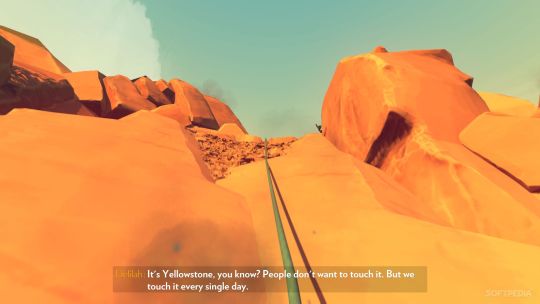
(Above) A screenshot of Henry abseiling down a sheer cliff face
The Radio: Henry has a radio with him that he uses to communicate with Delilah on the other end. A prompt will occasionally pop up that allows the player to initiate a conversation with Delilah, or respond to things that she says. When the player is looking at or holding something, the available prompts on what Henry will say is based on what they are seeing or holding.
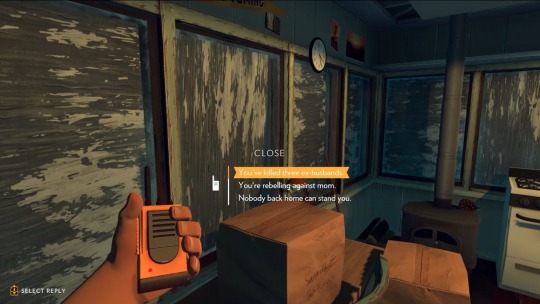
(Above) An example of the different prompts that pop up when the player uses the Walkie Talkie
Objects: Henry can pick up and inspect objects that he finds in the game world. When he picks them up, it can progress the story, or he can talk to Delilah about what he sees.
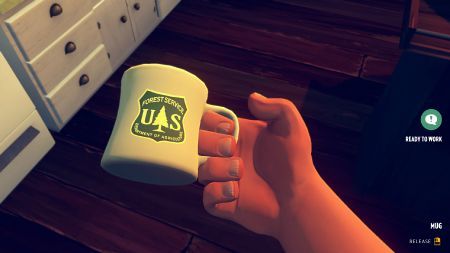
(Above) An example of an object that Henry can pick up and examine
In terms of the game’s influence, it doesn’t seem like Firewatch has had much of an influence on the industry. As Campo Santo’s release game, they didn’t have much of a following beforehand, so not many people would have been watching what was going to happen with Firewatch. In addition, the way that it tells its story is similar to other games, such as What Remains of Edith Finch, but it doesn’t act as a direct inspiration. It may have an influence on games that are yet to release, but nothing has really come of it since its initial 2016 release.
But, for a first time release, a sizable community has grown, with both a subreddit and fan wiki being created by the community. There is also the discussion boards on Steam. Both the Steam boards and subreddit are updated relatively infrequently, but a core group of players seem to gather there frequently.
Those communities can be found here:
https://www.reddit.com/r/Firewatch/
https://firewatch.gamepedia.com/Firewatch_Wiki
https://steamcommunity.com/app/383870/discussions
But in the end, Firewatch was a beautiful experience that brought together an incredibly compelling narrative, a beautiful world, and a story for everyone to share.
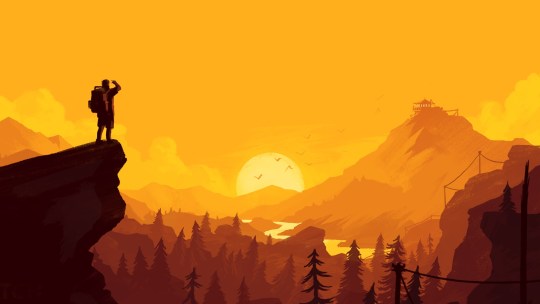
Sources:
https://www.polygon.com/2016/2/12/10966494/firewatch-agency-campo-santo
https://en.wikipedia.org/wiki/Firewatch
https://www.firewatchgame.com/
https://twitter.com/camposanto?lang=en
https://www.kotaku.com.au/2016/03/in-firewatch-your-choices-dont-matter-and-thats-okay/
https://www.theverge.com/2016/2/10/10960366/firewatch-interview-ps4-pc
https://guides.gamepressure.com/firewatch/guide.asp?ID=34088
https://panic.com/blog/firewatch-one-month-later/
https://www.polygon.com/2016/2/8/10900796/firewatch-review-pc-ps4-playstation-4-campo-santo
0 notes
Text
Unit 6 - Production Planning: Post Mortem
This unit is the first of two parts in which everyone from all three disciplines comes together to make a game. In our group, there are two designers, one of which is the producer (me), three programmers and six artists. Over the course of the next two units, every group is expected to make a fully functional game, with a proper game loop, mechanics, assets, the works.

(Above) The current logo for our game, Wave RiderZ. Covered more later in this post
For me, I learnt a lot about being a producer. Back in unit 2, I expressed the desire to be a producer in a later unit, and the chance to do it here has been a great learning experience. I am learning how to manage not only myself, but also a group of 10 other people. Scoping for each of them, keeping track of their progress with Burndown Charts and HackNPlan are all my tasks that I am learning how to do.
This also includes regularly consulting with the members of the other disciplines when scoping, so I am also learning about the general workflow of artists and programmers, and the pipeline that they go through. As an example, when I was initially scoping for the artists, I underscoped the amount of time it would take to make a single asset. After discussing with them and learning, I am now more confident in scoping for people with different skillsets.
I am also going over the iteration process again, since we need to bring our game through the Pre-Production, Alpha, Beta and Gold stages during this project.
When we first came together to discuss game ideas, I think my initial game concepts were solid. They were flexible enough that they didn’t have to stick with the exact formula that I had envisioned but had a strong enough concept that change wouldn’t hamper my original vision for them.
In terms of actual producer roles, I also think that I am managing people well. I keep all of the relevant producer documentation up to date as best I can, and always make sure that we run standup and that everyone is on the same page. I am aware of what everyone is doing pretty much all the time, only lacking when communication from the opposite party went missing.
Finally getting to work in a group has been great! We haven’t done anything in groups since unit 2, and getting to be in an environment with people who are dedicated artists and programmers should hopefully lead to a really strong project. I also really enjoy the majority of my group members. They seem hardworking but also laid back, but everyone meshes together really well. They all seem passionate about the project as well, which is fantastic.

(Above) The logo for our group, Anti-Fragile
Speaking of the project, I am thoroughly enjoying the game we’re making. It’s a 2-4 player party game called Wave RiderZ in which players alternate taking turns either controlling a Plane or being a Skier attached to the back. Players compete for points, with the plane having many tools at its disposal to disrupt the skiers. The idea had been iterated on multiple times in order to get to a state that we wanted, and I am very happy with the result.
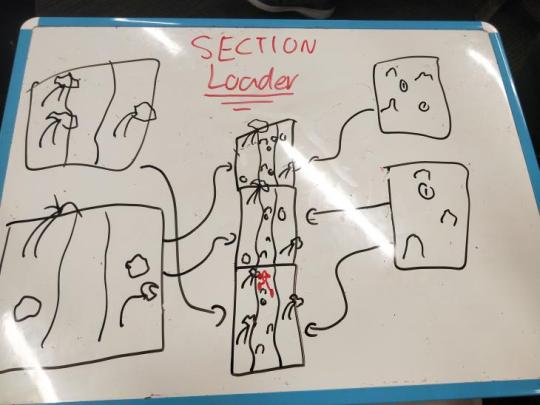
(Above) A design choice we made early on was that the level would be randomly generated at the beginning of each round, with a system randomly placing obstacle courses and environment pieces in a line to make the illusion of one long river
Going through the early concepting was also a lot of fun. Getting to see everyone’s game ideas be pitched, then picking one and slowly iterating on it was really fun and interesting. It helped show me just how varied everyone’s ideas can be. Once we had decided on our game, seeing everyone begin to take on their roles, such as one of our artists become our dedicated character artist because it’s her field of expertise, was also a great feeling because it indicated to me that the group is more than capable of making something good.

(Above) Very early concept art when deciding on the camera angle
Getting decisions made early on was quite difficult. Our team really struggled with deciding on what game idea we wanted to do early on, even going to a vote and ending on a tie between a horror game based on the Russian Sleep Experiment and a game about skiers being attached to a boat. We eventually decided on the boat idea and began to iterate on that, but even then, we struggled to come to ideas that we all decided on.

(Above) While concepting the rocks, the group struggled to decide on a design that we initially liked
I think that I need to get better at directing conversations and ensuring that we can actually reach decisions for things on time. Having group discussions was great, but having discussions that ultimately led nowhere wasn’t. As an addition to that, I also need to get better at corralling my group back into work. Some of our group members, myself included, will often break off from whatever task they are meant to be working on and get distracted or wander off. It’s my job to ensure that doesn’t happen, and I need to do better with it.
I am also struggling to, once again, ensure that I am managing myself effectively enough. I think I’m keeping good tabs on everyone else and making sure that they are doing their work, but I’m not applying that same principle to me. I just need to put myself in the right gear and start treating myself as part of the team, rather than treating myself and my time as removed from everyone else’s.
But this unit is overall shaping up to be a blast! It looks like the group is going to get along really well, and hopefully we come out of it with a game to be proud of!
0 notes
Text
Hearthstone: Slightly Problematic Design
One of Hearthstone’s greatest draws is also one of its biggest detractors. Since the game is completely virtual, it can afford to introduce an element to its gameplay that cannot be present in physical CCGs or TCGs: randomness. Since computers can account for and do things that are physically impossible to do in real world card games, Hearthstone is able to use and rely on cards and mechanics that require a semblance of randomness.
What this leads to is situations in which one player gets a favourable result from a card, with no way to react to it. As a result, skill based play often becomes less favoured, instead letting strong random cards exist and become problematic, both in casual and in proplay. Skill based decks do definitely exist, but the RNG present in many cards makes it hard to create decks that have none in them. Card Keywords such as Discover and Recruit are also completely dependant on RNG, and they are very present in lots of modern cards.
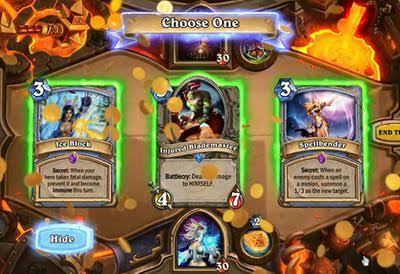
(Above) An example of how discover works: providing a choice of three random cards to the player, of which the other player cannot see
Cards like Sylvanas Windrunner, Ragnaros the Firelord and Yogg-Saron, Hope’s End, all saw lots of play because their effects were incredibly strong. But, each of them was based on a random effect that the opposing player often didn’t have a chance to react to. Yogg-Saron in particular was such a prevalent card in the meta due to its ability to completely swing games in either player’s favour that people called for it to be banned, with it eventually being nerfed as to not continue wreaking havoc if it dies or transforms.

(Above) The bane of any Hearthstone Player’s game
While RNG allows for games to be different when the same deck is constantly played, the often unpredictable nature of said RNG and the heavy reliance on it takes away from the possible skill that’s already present in Hearthstone.
As with any card game, new cards are released yearly in different expansions, adding new cards for players to use and experiment with. However, Hearthstone being a digital card game allowed for players to gain cards in a different way; Solo Expansions. Instead of buying packs and getting 5 cards at random, players could instead buy Solo Expansions, which were made up of 4 wings, and battle against AI opponents with special hero powers and decks to earn cards. Beating bosses would earn them cards for the different classes, and beating all of the bosses in a Wing would give players a special legendary card. Many players found the first few Solo Adventures, ‘Curse of Naxxramas’ and ‘Blackrock Mountain’ to be fun and enjoyable, since the boss fights were interesting and unique, with new cards being available, with players always knowing what they would get.

(Above) An example of the old shop that contained the first two solo adventures
This then pivoted into different free content that kept the a similar solo adventure model. The expansion “Knights of the Frozen Throne” had a completely free solo adventure released with the expansion, but with less rewards. Players could only earn one Legendary card, which was one of the nine “Death Knight” hero cards at random, as well as 3 packs from the set. The expansion “Kobolds and Catacombs” introduced a gamemode called “Dungeon Run”, a mode where players would face a series of bosses one at a time, building a deck from random sets of cards as they went. The bosses they faced were randomly pulled from a list, but like previous solo adventures, they each had their own decks and gimmicks that were unique to them. Playing the gamemode wouldn’t net any rewards unless the player received a daily quest to do so, but it acted as a good distraction and solo task that players could undertake. This formula was repeated similarly in the “Monster Hunt,” “Puzzle Lab” and “Rumble Run” free solo adventures that were released with each of the expansions in the next year. Rewards for completing the expansions were limited to singular cardbacks, and the packs became non existent except for quest rewards.
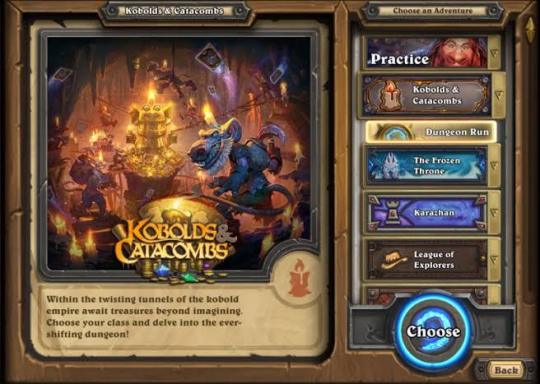
(Above) Some of the earliest free adventures that were a part of Kobolds and Catacombs and The Frozen Throne. Under them are the Karazhan and League of Explorers expansions, which were paid content using the traditional Solo Adventure formula
2019 also saw the release of Dungeon Run-esque solo adventures with its first two expansions, “Rise of Shadows” and “Saviours of Uldum,” except this time they are paid expansions. Costing about $20 AUD, the adventures are now broken up into a series of different “Wings” like the original solo adventures, but they are structured closer to the Dungeon Run style of gameplay. They also offer more rewards than the free expansions beforehand, but now give packs instead of any guaranteed cards.
The solo adventure and repeated boss fight model that was popularised with the “Dungeon Run” and “Curse of the Witchwood” game modes was used again in content for the expansions but as paid expansions instead. The cost of buying the amount of packs you would get as rewards for completing the adventure is cheaper than buying the packs outright, but there is no guarantee for what cards the player is going to be receiving from their packs, unlike the previous paid solo expansions. At the current rate that Hearthstone is progressing, it seems that this is going to become the norm, and the free content and guaranteed rewards that used to be a big part of increasing your collection are going to be less prevalent, if present at all.

(Above) The Tombs of Terror solo expansion within the Hearthstone shop
Speaking of rewards, the way that Hearthstone gives cards and resources to its players is also quite flawed.
Hearthstone utilises two in game currencies: Gold and Arcane Dust (Often just called Dust). Gold can be used to purchase packs (100 gold a pack) or wings of solo adventures (About 700 gold per wing). Gold is earned either by completing daily quests, where the player needs to complete certain tasks to earn between 50 and 100, and for every three wins a player gets in a day (To a maximum of 100). Arcane dust is earned by “Disenchanting” extra cards that the player doesn’t want.
Players cannot spend money to directly buy either currency, with money replacing the need for gold in many cases, and dust being acquired as a result of disenchanting the cards bought with gold.
Unlike physical card games, cards in Hearthstone cannot be traded, sold, or given away. When a player opens a card from a pack, they can either disenchant it or keep it, with no way for that card to go to another player.
The problem with that is that with physical cards, spending money on lots of packs can become financially worth it if you open an “expensive” card, since that card can be sold to make back the money that was spent on the packs, or the person who unpacked it no longer has to buy it, so the money that would have gone to acquiring it isn’t spent. In Hearthstone, this isn’t the case. Spending the same amount of money on Hearthstone won’t end in the same result though. Money spent cannot be given back in any form that is not the ingame currency, meaning that investing money or putting money into the game gives no physical, real world reward.
This is made even worse by the fact that some newer cards are similar in effect to older cards from the basic set, but are so much more powerful that there’s no reason to run the original. This has always been a problem in Hearthstone, but within the past year it has reached a point of borderline ridiculousness. The newest expansion, “Descent of Dragons” in particular has revealed a slew of cards that completely outclass cards from the original set.

(Above) An example of the powercreep in the new set. Amber Watcher is a strictly better Guardian of Kings for less mana, and with the ability to work with Dragons
While increased power in cards over time is good, powercreep of this level isn’t. Players who do not have easy access to these new cards become left behind while players who do get access to better resources, which lets them win more games and get further ahead on the ranked ladder. Resources, as discussed before, that are hard to get without spending money.

(Above) Another example of the Powercreep found in Hearthstone cards. This time, a Neutral Rare card is strictly better than a Priest Common
Hearthstone being digital also means that it has the ability to either increase or decrease the strength of certain cards in order to keep the game balanced. As part of their ability to do this, the Hearthstone team will allow players to Disenchant any cards that received a nerf for the full dust price instead of the normal price.
As a result, it’s rare that more expensive cards will get nerfed, since Hearthstone’s dust economy revolves around players always needing to have more. And if players can turn worse cards into better cards, then the economy that Hearthstone is trying to maintain suffers. So, as a result, card nerfs are often quite rare. This means that until new cards are released, cards rotate, or nerfs happen, the meta tends to stagnate like other card games.
And while it’s good that the Hearthstone team will make nerfs, some come too little too late. As an example, the nerfs to the cards “Patches the Pirate” and “Raza the Unchained” were both significant nerfs to decks based around pirates, and what was known as “Machine Gun Priest” respectively. The problem was that the cards were nerfed just two months before they rotated out of Standard and became playable only in wild. That meant that the cards were still at the peak of their strength for nearly two years before the Hearthstone team did anything about them.
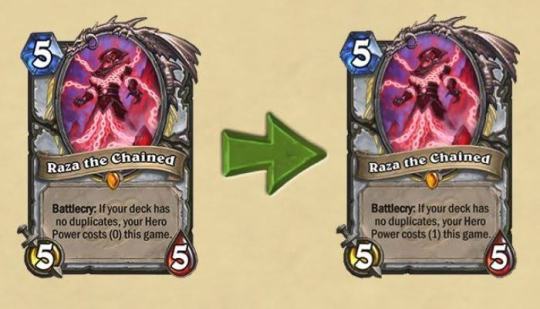
(Above and below) The Patches the Pirate and Raza the Unchained nerfs
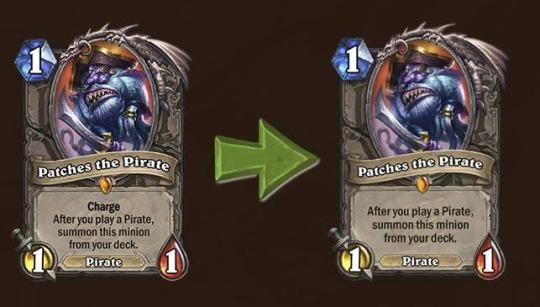
To conclude, I don’t think that Hearthstone is terrible as a game. I just think that some elements of its design and its business model are problematic and could use some fixing. This post served to highlight what I believe to be the most problematic areas in that design.
Links:
https://dotesports.com/hearthstone/news/yogg-saron-competitive-hearthstone-ban-3781
https://de.egamersworld.com/hearthstone/news/firebat-announces-quot-batstone-quot-the-first-community-ban-hs-tournament-EJHCz46sb
https://hearthstone.gamepedia.com/Expansion
https://playhearthstone.com/en-us/expansions-adventures/rise-of-shadows/
https://powerup-gaming.com/2019/09/06/saviors-of-uldum-tombs-of-terror-is-hearthstones-next-solo-adventure/#:~:targetText=Finally%2C%20a%20special%20Tombs%20of,Terror%20begins%20on%20September%2018.
https://us.shop.battle.net/en-us/product/hearthstone-tombs-of-terror-adventure
https://hearthstone.gamepedia.com/Card_changes
https://www.hearthpwn.com/news/4349-patches-the-pirate-loses-charge-four-card-nerfs
https://www.pcgamer.com/au/hearthstone-is-finally-nerfing-dr-boom-and-several-other-problem-cards/
0 notes
Text
Accessibility in Video Games
It wasn’t until I started studying games design that I really learnt what it meant for games to be accessible. Many elements of a game that made it accessible I took for granted, since they weren’t something that were necessary for me.
First of all, it’s important to define what exactly is defined as “Accessibility.” As a broad term, Accessibility is defined by the dictionary as the following:
1. the quality of being able to be reached or entered.
2. the quality of being easily understood or appreciated
3. the quality of being easy to obtain or use.
In relation to video games, this refers to designing and making a game in such a way that a larger audience of players are able to access and enjoy the gameplay and game experience.
An example of an accessibility element that many players use without even realising the accessibility it gives are Subtitles. These are added often for those who are hard of hearing, so that they may still understand what the characters are saying, but many players would still use them when there is a lot of background noise, or if they can’t use a high volume setting. The accessibility that they offer can be controlled as well. Just having subtitles often won’t work, but having them be written in a large and easy to read font increases the accessibility that they provide. Having the text stand out and clearly contrast from the rest of the game screen also helps readability.
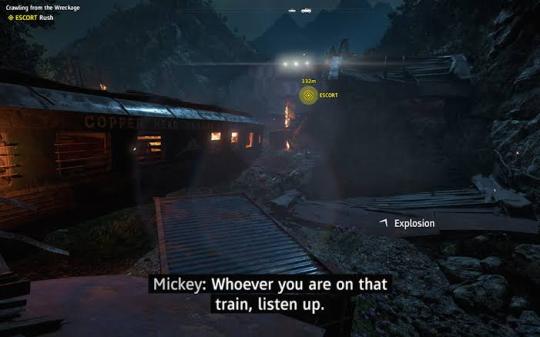
(Above) Far Cry new Dawn’s subtitles
https://trends.cmf-fmc.ca/subtitles-in-video-games-the-best-practices/
https://www.gamasutra.com/view/feature/132315/subtitles_increasing_game_.php
Other ways to increase accessibility include using shape to distinguish different objects rather than colour to help colourblind people, and the addition of colourblind modes in general. Many competitive games, such as Overwatch and League of Legends include a colourblind mode that changes the colours of many elements of the game, such as health bars and team colours, in order for colourblind people to easily distinguish between allies and enemies.

(Above) The colourblind settings in Overwatch, which lets players choose what colours certain elements of the game are presented as
(Below) An example of what the League of Legends colourblind mode does, changing the green health bar and player number to yellow, and Tahm’s “Grey Health Bar” to a lighter shade

https://www.slashgear.com/overwatch-gets-updated-colorblind-feature-with-nine-color-options-21546973/#:~:targetText=Though%20Blizzard's%20hit%20game%20Overwatch,entire%20look%20of%20the%20game.
https://support.riotgames.com/hc/en-us/articles/201752844-Colorblind-Mode#:~:targetText=We%20have%20implemented%20a%20mode,as%20spell%20effects%20during%20gameplay.
But why is accessibility important?
Because we want the games that we make to be playable and enjoyed by as wide of an audience as possible, and a game not being accessible is the biggest barrier for entry to that. If a game is inaccessible to members of the public, then they don’t have the opportunity to experience the game firsthand. Games are a form of entertainment, and stopping certain people from accessing that entertainment is bad for both consumers, who cannot interact with a possibly enjoyable product, and producers, who loses out on consumer sales due to a lack of accessibility.
Games also often provide an escape for players, allowing them to go on high stakes adventures or engage in epic quests. For people with disabilities in particular, this also means that players with a disability are provided “an escape from the limitations of being disabled” as said by Josh Straub, Editor in Chief for DAGER system. It also provides a social space where players are judged by “actions taken and results produced inside the game” rather than physical appearance.

https://dagersystem.com/consulting/
Straub spoke to Naughty Dog’s UI designer, Alexandria Neonakis, at GDC when Uncharted 4: A Thief’s End was in development. He spoke of how, despite being a huge fan of the Uncharted series, he was unable to complete the second game due to needing to button mash to open a door near the end of the game. His story of how he was unable to complete the game due to a lack of accessibility and help that prompted the Naughty Dog team to include an entire section for accessibility in the game’s menu. They added a variety of options in that section, such as allowing players to hold down a button to treat it like they were repeatedly pressing it, replacing the need to mash at all, which helped not only with opening doors but also with the melee combat. Considerations were also made to have as little of the game need the right control stick as possible, which led to the camera panning or moving on its own when the player enters certain sections in order to move enemies into the line of sight of their weapons.
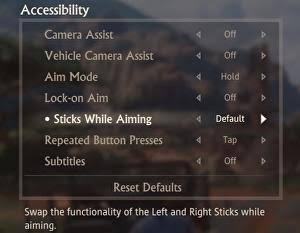
(Above) The accessibility menu in Uncharted 4: A Thief’s End
These considerations weren’t a necessary part of the game; Uncharted 4 could function completely on its own without them. But the consideration to have that accessibility means that the game can be played and enjoyed by a much wider audience, including long time fans like Straub.
https://www.youtube.com/watch?v=Ls_CD4mB42s&feature=emb_title
http://www.gamesindustry.biz/articles/2016-05-20-uncharted-4-is-a-paragon-of-aaa-accessibility
https://www.gamesindustry.biz/articles/2016-05-27-accessibility-in-gaming-should-be-the-rule-not-the-exception
Accessibility is incredibly important in creating a strong and unified game industry. The number of gamers with disabilities is on the rise, with 33 million in the US alone having a disability as of 2017. If the games industry wants to expand itself to a wider audience, then keeping accessibly as a core design decision is a necessity.
https://www.gamasutra.com/view/news/117330/Analysis_Game_Design_Accessibility_Matters.php
https://venturebeat.com/2019/10/08/accessibility-finally-matters-to-the-game-industry-but-it-needs-to-do-better/
https://geekandsundry.com/ablegamers-making-gaming-more-accessible-to-33-million-disabled-gamers/
0 notes
Text
Unit 5 - Testing and Quality Assurance: Post Mortem
Unit 5 was focused on Testing and Quality Assurance. This was our shortest unit, and there was no big assignment that we were required to create as we went. Instead, our class was tasked with each testing a different game. We learnt about different kinds of testing, including bug testing, user testing and smoke testing, and had to apply that knowledge to the games we were given, which were all recent games on itch.io, most of which were created as some form of a Game Jam. We each did the bug and smoke testing on our own games, and then had to do user testing with other people, recording their gameplay and giving them a questionnaire to fill out when they finished.
The game I was tasked with testing was called “Static End” by Blood Machine. Its an atmospheric horror game reminiscent of the PS1 era, with the same art style and controls scheme.

https://blood-machine.itch.io/static-end
Testing other peoples games and giving feedback was comprehensive and useful, as were the bug reports that I compiled while playing the game. I find that questionnaires are usually very easy to answer if more technical information is required, as the breaking up of information allows for an easier writing process.
Compared to previous units, I also think that I managed my time so much better with this one than previously. This may be due to it being a shorter unit and having no overarching assignment that needed constant iteration. Regardless, I felt more in control of myself and my time with this unit.
Bug testing is fun when you find something that really breaks the game. Getting to mess around with it and exploit bugs that don’t serve any sort of gameplay purpose but are fun to do is quite enjoyable. The process, initially, is also really fun. Getting to explore each nook and cranny of a game and find what works and what doesn’t lets you have a completely different outlook on how the game was made and functions.
The repetitive nature of Bug Testing got did old really quickly though, which led to a small decline in testing quality over time. Once you’ve played enough of a game, especially one as short and starved for content as Static End is, trying to test it becomes incredibly boring. I think an issue that came with that is that I burned out while playing really quickly due to doing so much testing, so I ran dry of game pretty quickly. What I did test was still good in the end.
This unit was short, but sweet. I don’t think it’s close to my favourite at all, but it was a solid learning experience to see how QA works.
0 notes
Text
Unit 4 - Narrative Design: Post Mortem
Unit 4 was narrative design, the unit that I’d been most looking forward to all year. In it, we were tasked with making a Vertical Slice for a game, that had to have all of its assets and code complete. It acted as a bridge between all of the previous units, requiring skills in writing and design documentation, art in both modelling and texturing, and programming. We also discussed what exactly goes into a narrative, and how to convey elements about a game to the player without having to tell them directly.
We started each day by playing part of a narrative based game and discussing it among the class, which was so much fun. Getting to properly dive into what makes each game’s narrative, and how its presented, with a group of likeminded people is one of the main reasons I came to this university. We discussed a variety of games, such as Firewatch, Journey and Shadow of the Colossus.
I also enjoyed a lot of the background work that went into making my vertical slice. Doing all of the documentation for the world and the main character was a great introduction for what I want to do later, since I would also like to work in more narrative based games. The process of then creating a vertical slice based on all of that documentation, and getting to use a combination of my skills that I’ve been building up over the year was enjoyable as well. A big part of why I enjoyed it, to me at least, was that I felt comfortable doing it and that I was good with the writing. Even on a conceptual level, I think that my vertical slice had some really good ideas and motifs, but that may be due to a more biased point of view.
The vertical slice is from a game called “The Mind and Times of a one Mr Rodger Nelson.” It follows the story of a man down on his luck named Rodger Nelson, who has an “Avatar” in his head that can interact with his thoughts, emotions and memories, known as Entities of Thought. It is his Avatar’s job to defeat the negativity inside of his head, exploring the different facets of Rodger’s mind that represent different parts of his life, such as his marriage and his job.

(Above) The terrain in this office like area slowly begins to deteriorate as a representation of the deterioration of the person’s mind
The same problems I had in the programming unit about getting stuck did come back in this unit, though much less prominent. I still faced a few issues that I got too fixated on in the programming side, but otherwise my workflow was relatively smooth. That being said, I don’t think my time management was as good with this unit either, mostly through me severely underscoping how long it would take to do things and not keeping enough extra time as a buffer just in case more time was needed. Time management is, once again, something that I need to improve when working on a solo project.
I also wasn’t super happy with the end result of some of my assets, so I definitely think that I’d want to put more thought into them next time. Conceptually, I think that the ideas I put into them were good, but I lacked a strong enough execution to really show those concepts. As a result of the poor time management and obsession with fixing problems, I didn’t put as much effort into the art side as I should have.

(Above) The final design for the player character, which is meant to be based on a simplistic starship design
But overall, this has definitely been my favourite unit so far. It had the most substance out of the past 4 and the discussions were really insightful and informative.

(Above) The Avatar defeating Entities of Thought within Rodger’s mindscape
0 notes
Text
Unit 3 - Design Prototyping Fundamentals: Post Mortem
Unit 3 of our studies was focused on the prototyping process and on programming. Our end goal was to create a playable prototype of a game, in which the game itself was fully functional, but the rest of it (The art, sound design, etc) didn’t need to be finished.
Throughout this unit, we learned about the process of iteration in order to create prototypes, and the buildup of projects and ideas over time. This includes moving from paper and physical prototypes to actually creating things in code, the iteration process, and building and expanding on ideas to create a better product. All of the programming that we did was through C#, which is the default language that Unity coding is done in.
I think that I handled the iteration process well enough. I’m good at coming up with initial ideas, and learning how to build on them helped make that process even easier. It was fun. Getting to expand on ideas as opposed to just making one and sticking with it, like I used to do with most projects before coming to university, is a great way to enjoy what you are making. Getting to do actual physical prototypes as well to test if the concept works was also really interesting.

(Above) A stop motion gif of one of my early Physical Prototypes for my game
The programming itself was also a lot of fun. When we really got into making things work, and having ultimate control on how they worked, the unit really started to pick up.
My prototype was for a game called “Vertical Escape” where the player must shoot falling platforms with a freezing gun in order to make them stop moving so they may jump on them and reach the end of the level. The game was originally going to be a horizontal endless runner where the player would move left to right and freeze obstacles out of their way, but through the iteration process, I changed it to vertical instead of horizontal, and put more emphasis on the obstacles becoming platforms. Putting all of the pieces together slowly as I went was really fun, and having a working prototype was great!

(Above) A very early version of the prototype
The problem though, was that throughout the project, I got stuck. A lot. I’d begin to face a problem and, due to my lack of knowledge, would find myself unable to fix it. It also didn’t help that I had a tendency to fixate on my problems until I was able to solve them.
I also wasn’t happy with myself when it came to my submissions. As a result of constantly getting stuck and not fixing problems in time, my Alpha and Beta submissions didn’t really work as intended. The movement of the character and the shooting was incomplete in the alpha build because I forgot that DeltaTime existed, and the spawning script for the platforms didn’t work properly either.
I think that, in the end, I simply didn’t do enough work outside of class to really help me get a full grasp of this unit and its contents. Compared to the last two units, I definitely did less work outside of class, which really showed in how good of a prototype I was able to make.
In addition, I would definitely want to budget my time better next time. As I said before, I constantly got stuck while working, especially when I made a game build, and I often didn’t have enough time to fix everything to make a submission the way I wanted to. This goes hand in hand with doing more work outside of class, since I could then budget more time for testing.
This unit was a struggle, but I ultimately still had a lot of fun in the end. The programming was enjoyable, the iteration was fun, but not bolstering my skills enough is what really held me back from enjoying this unit to its fullest potential.
Here is a link to a final gif of the prototype: https://imgur.com/a/TsoZepS
0 notes
Text
Unit 2: Level Design (Post Mortem)
Unit 2 was all about level design. This included a dive into learning how to create levels and assets, understanding how the artists work, and becoming incredibly frustrated at Autodesk Maya for being Autodesk Maya. We learnt how to model using Maya, as well as unwrap UVs to create textures, expanding upon what we learnt in the last unit. This included not only making better textures, but also incorporating the usage of normal maps and alpha channels to create more distinct and shaped textures, rather than ones that were simply flat materials on an object.

(Above and below) The result of unwrapping objects in Maya and applying textures. The bears were more properly unwrapped and textured, while the poles simply had tiling textures added to the relevant geometry

Our final assessment was to make a level for a game based on a location in Melbourne, with my team of 4 making a level based off the QV. The game’s mechanics were already defined for us, we were simple responsible for making the level.
(A link to a video showing the gameplay can be found here: https://www.youtube.com/watch?v=DdDWapLUcMk&feature=youtu.be)
Since we were doing this assignment in teams, we also learnt how to use various tools so that we could function as a team, including the usage of HackNPlan for the first time, using SVN to manage files, and the usage of a burndown chart.
I managed to get SVN working really well for me, and understood some of the nuances of the program really well when I was using it properly. Other groups said that they often struggled with the program, but I feel that I was able to utilise it to the best of my abilities, which led to a much smoother experience.
I also think that I designed my parts of the level well. As a team we all collectively decided that the space would consist of an upper and lower floor, but we were each working on different parts of the level. I focused mainly on the stage area, designing and modelling most of the assets in that space. I also think that I brought a good strength to my team with how I helped put the assets into the level to still be reminiscent of the QV space, but still make it fun for players to interact with.

(Above) An in-unity shot of the stage area I was responsible for
Though I struggled with Maya often, I did thoroughly enjoy the concept and process of modelling things. Starting off with simple geometric shapes and then slowly evolving them into an actual object is a really cool and fun process, if a little frustrating at times.

(Above and Below) Examples of my first time doing any modelling in Maya

Actually looking at level design was really enjoyable as well. There are so many more things that go into making a good level and gameplay experience than I initially thought. Though we didn’t spend as many lessons on just designing our own levels, we learnt enough across them and other theory based lessons to get a strong enough understanding of the concept for our project.

(Above) An in unity image of a level made using a modular toolkit. Triggers were used at certain points in order to make text appear and complete the experience
I was placed as the Project Wrangler for the group, meaning that it was my job to ensure that all of the necessary files and documents relating to our group and the project were kept together and were managed correctly. As someone who frequently was designated the group leader in highschool projects, I felt right at home in this role.
Even just working in a team was enjoyable, as the skillsets that each person brought to the group was different enough to create a more united experience. It also helped that I was already friends with the other three members, and thus the project we worked on managed to feel more like a solid collaboration that just straight up work.
I found Maya to be an absolute chore to work with sometimes. While I was lucky enough to not be faced with any of the standard crashing and performance issues that Maya users often face, I still often struggled to make my best use of the program. I found the UI confusing and would often find myself being unable to fix my work after making a mistake due to the undo function not working. I also found the porting between Unity and Maya to be troublesome, either due to scaling not carrying over correctly or the models themselves not looking the same in one program as they did in the other, but that was most likely my fault. I just didn’t manage to get my head around the way to properly utilise the program.

(Above) A tiling table set I made in Maya that required too many iterations in order to port over to Unity correctly
In terms of what I would do better next time, it comes in twofold. One is that I needed to make sure that my skills were more well-rounded at the end of the project, as it felt like I was putting more effort into understanding the concepts and ideas than i was into the technical skills themselves, both on a knowledge and an ability level. This would involve simply spending more time working with the programs we used and gaining a better overall understanding of how they each work. In particular, I felt that my texturing skills were the most lacking, both UV unwrapping and the texturing process itself.
I also think that our team communication was ultimately lacking, so I would like to take initiative next time and make sure that my team is communicating better. In addition, the overall time management of my team is something I’d also like to improve. I’d like to get a producer role later in the year so that I may help hone these skills.
But despite my troubles, this was a great unit. I had a lot of fun with it, and am very much looking forward to doing more level design things in the future.

(Above) A shot of our final level from afar
1 note
·
View note
Text
Monument Valley: An Exploration
Monument Valley
Publisher: Ustwo Games
Twitter: https://twitter.com/ustwogames?lang=en
Year of release: 2014
Monument Valley is noteworthy in its approach to level design. Through its usage of an isometric camera and a camera angle of 45 degrees, the game is able to create level geometry that should be theoretically impossible by normal means.

Examples of levels from the game
Reminiscent of MC Escher paintings, Monument Valley breaks the way levels are presented, creating optical illusions that the player can use to progress throughout the levels. Couple this with Ida (The princess the player controls) being able to walk onto walls should there be a curved surface, the game is free to havelevels that other platformers and puzzle games similar to itself simply cannot achieve.
The game forces the player to think outside of the box when it comes to finding the correct solution to progress through a level, as the perspective they have at any given time may need to be altered in order to progress.
I found that the game was super easy to pick up and understand. Its main difficulties came from attempting to discern how pieces of the level fit together.
Despite how easy the game was to pick up, its difficulty ramps up by a massive amount in the final levels. While the first eight see a gradual increase in difficulty and adding of mechanics, the final two felt more like trial and error at some points. While this could be mostly attributed to me just being bad at the game, some parts of the level just felt overall confusing. I eventually powered through it, and the satisfaction of being able to finally complete the game was amazing.

The game’s final level
The game’s story was also nice, though I didn’t fully understand it on my first play through. The history of the protagonist, Ida, made little sense to me to begin with, but it all came together by the end.
Upon its release, the game was incredibly well received, being praised for its unit styling and level design by both fans and critics. Even to this day, the response has remained positive, with it having a 4.5 star rating and being the #5 puzzle game on the Itunes Store. In addition, it also won the Apple Game of the Year Award in 2014, as well as the Apple Design Award for the same year.

A screenshot of the game’s reviews on the App Store
Monument Valley’s core loop is based around the player loading up a new level and progressing through them using the tools they have at their disposal. This includes moving terrain, stepping on switches, moving the totem friend, and moving Ida around the level to progress to the next point of the level.

The game’s core loop
The levels are built of terrain that can we walked on, or parts of the level that can be interacted with.

The dots on the bridge indicate that it can be moved by the player
The player controls Ida by tapping a space she can move to, or tapping and dragging on her around the level. As long as Ida can reach the area the player taps, she will automatically move to that space, which includes walking onto walls if there is a curved surface, or using a set of stairs. If she cannot move there, she will instead not move.
The player can also interact with parts of the level, such as large wheels they can turn or sections of a wall they can drag up or down. Spaces like this are often denoted by ridges in the level geometry, and cannot be moved if Ida is standing on top of the part of the level that would be affected. The player also gains access to a Totem companion later in the game, who can be moved by the player, even when Ida is standing on top of them.

The totem companion that joins the player and can be moved by them
Monument Valley has been pretty unique in its design since its inception. The games Outside World and Ghost of Memories both may have been inspired by it, at least aesthetically. Both games are puzzle games that involve tapping on chunks of a floor to move a player character, with them sharing the same 45 degree isometric camera. But while Monument Valley focuses on breaking the typical style of level design and dynamics, Outside World is closer to traditional puzzle games that utilise the player needing to solve puzzles to progress, rather than traversing the level by shifting geometry.

A screenshot from Outside World
Ghost of Memories may have also been inspired by Monument Valley. Like Outside World, it shares the same camera style and level building as Monument Valley. In contrast to Outside World, this game does involve scenarios where the player has the ability to influence parts of the level’s geometry in order to progress, which is closer to Monument Valley than Outside World it.

A screenshot from a level of Ghost of Memories
Otherwise, Monument Valley is very unique in its style of level building and player movement, and games that could have been inspired by it after its release are few and far between.
There doesn’t seem to be that large of a community for this game. Those that can be found are mostly on the game’s subreddit, which can be found here:
https://www.reddit.com/r/MonumentValleyGame/
Despite the lack of a consistent community, the game is still drawing in new players and is garnering critical acclaim to this day from players and reviewers. While they may not be a part of an overarching community, they still hold the experience they had playing the game dear to their hearts, as do I.
Links and Bibliography:
https://www.pocketmeta.com/top-10-mobile-games-like-monument-valley/
https://en.wikipedia.org/wiki/Monument_Valley_(video_game)
https://apps.apple.com/au/app/monument-valley/id728293409
https://www.ustwo.com/work/monument-valley-mobile-games
Outside World:
https://www.youtube.com/watch?v=IxmFOSHUur0
https://www.youtube.com/watch?v=evZ2RPe6oVA
Ghost of Memories:
https://www.youtube.com/watch?v=qfQ3B5m1cWo
https://www.youtube.com/watch?v=vb_J5sOZI3M
1 note
·
View note
Text
Orwell: Keeping An Eye On You
Publisher: Osmotic Studios
Release Year: 2016
Steam: https://store.steampowered.com/app/491950/Orwell_Keeping_an_Eye_On_You/
Games like Papers Please and Not Tonight have always intrigued me. The concept of taking a seemingly mundane task (Being border security or a bouncer) and translating that into a game that people play and actually enjoy is such a fascinating concept, which is exactly why I had to have a go at Orwell: Keeping an Eye On You.

You play as an investigator, using a digital system called Orwell to track and probe into the lives of people believed to be linked to a series of terrorist attacks.
The game is particularly noteworthy due to its blend of narrative and gameplay, and the impact that the player has on the overall progression of the story. It’s up to the player to analyse all of the data presented to them, and make their own judgement calls. The detectives and law enforcement partnered with the player only have access to the information the player provides, so it is up to them to deduce what information they steal from private lives and put into the Orwell system.
The game was short, but fun. I found the story to be super engaging, and found myself drawn into its characters and stories the entire way through.
The game also makes the concept of spying into the private lives of individuals and recording personal information not only fun, but justified. The game presents the player with a sense of morality, in which they are encouraged to focus more on protecting ‘the greater good,’ while still having absolute control of the end result
I also found it intellectually challenging. Not difficult, per se, but more it forced me to really think about what you were reading, and fully read between the lines in order to understand what was being presented, and what I was going to be placing into the Orwell system.

The heavy narrative driven gameplay also never felt stale, as each day presents new challenges that ties an overarching story together.
The response to the game was warm, with it garnering positive reviews that have maintained throughout its release. Whilst it didn’t create a large following behind it like other games, it’s following, though small, is incredibly strong. The majority of the game’s community is found interacting with the studio that made the game, Osmotic Studios, on Twitter., which can be found here: https://twitter.com/osmoticstudios.
The game also spawned a sequel; Orwell: Ignorance is Strength, which received similar praise to its predecessor.
Core Loop and Mechanics:

The game’s core loop revolves around identifying data chunks and comparing them to information already gathered by the player, and deciding what the correct course of action is.
The only interaction that the player has with the game is opening information sources, reading them, and dragging “data chunks” into a relevant character profile. The choice on what data chunks to move is determined by the player, who decides if they think the information needs to be recorded or not. Once a data chunk has been entered into the Orwell system, there is no undoing it, so each choice does matter, as incorrect information can lead to incorrect responses from the detective and response team the player is working with.
Once the game progresses, conflicting data chunks also begin to appear, in which two or more chunks contain pieces of information that conflict with each other. In this case, it is the player’s choice as to which chunk they put into the Orwell system, as once one is entered, the other chunks cannot be. This is often where player choice and deduction is most key, as they must deduce what the correct information is, as opposed to just whether it needs to be recorded.
Altogether, I found the game to be a surprisingly enjoyable experience, that I would recommend to anyone wanting a unique take on detective work.
0 notes
Text
Unit 1: Post Mortem
At the end of each unit, students in our class are expected to complete a blog post detailing our experiences in the unit. Here’e mine
What we learned:
This unit was our introduction to the world of Game Design, and being given the understanding of the tools necessary to succeed in the field, as well as what interacting with the field itself would entail. This included the basis of what made a game, such as the definition and understanding of the MDA Framework (Mechanics, Dynamics and Aesthetics), and learning to stop looking at games as a consumer of the medium, but rather a creator of the media.
The tools we learned to work with in this unit were Unity and Photoshop, which are two of the most key tools a designer will be working with.
With Unity, we have looked at modelling and creating scenes/environments using the tools provided with it. This has included attempting to recreate a piece of concept art completely in Unity through manipulation of the object prefabs it provides.

Original Concept Art (Above) and Recreation in Unity (Below)

With Photoshop, we learned the basics of texturing and the tools that it provides to manipulate photos.

Texture made in Photoshop based on a real image (Above) and that same texture applied to a box in Unity to observe its tiling effect (Below)

What I did well:
I feel that my ability to help others has been of a severe boon to me, and to them. By analysing the work of other people, and critiquing them, I am not only able to help them achieve more, but I can also see, based on their work, where I need to improve.
I latched onto new concepts and things being learned pretty quickly, and thus I was able to help other people understand what was going on, which felt more helpful than critiquing what they had already done.
I also almost filled up an entire notebook with notes on lectures and videos we watched in order to help with my understanding. I feel that most of it will be beneficial in some way, but I may need to work on my organisation of the book a little better.

A Rube Goldberg style machine that (Albeit simply) performs a set of physics actions to a ball after it is pushed
What I liked:
The fact that this class is such a great place of discussion and learning for things that I am interested in has been amazing. Class discussions in which everyone gets a chance to participate, ask questions and voice opinions has been a great way to learn about everyone in class and see opinions from people that you might not see anywhere else. Compared to high school, where everyone was very separated in their goals and aspirations, these discussions are great because everyone has the same overall goal in that they all are taking the course, but are still individual in what they want to get out of the course.
I’ve been able to meet with some great people and learn some amazing things along the way with them.
Unity is always fun to work with, and learning about the existence of Probuilder was fun. I had used Unity previously in High School, and attempting to create objects out of a series of squares was always difficult, but Probuilder made it easier.

My first attempt at using Probuilder (Above) and a rough recreation of the layout of my house created using it (Below)

What I found difficult:
My tendency to focus on one element of something I am creating too heavily was a drawback in some scenarios. Instead of attempting to create more of a whole, completed picture that was of an above average quality, I would spend more time attempting to finalise and perfect smaller elements of whatever I was creating

The second piece of Concept Art I used as a basis (Above) for my work in Unity with Probuilder (Below)

Photoshop is also really tough for me to understand and pick up. The program lets you do so much, and I struggled to get my head around the basics of everything. It might be because there is simply so much to it, or because I am only in the beginning stages of learning how to use it, but the task of having to interact with it constantly seems daunting. This, however, is something that I will hopefully find less difficult as i continue to work with the medium.

My first attempt at using Photoshop and understanding how layers worked, by drawing over Batman Park and the Melbourne Helicopter Tours pad
What I would do better next time:
Ultimately, I think I need to learn when to stop working on something in order to move on and place my focus elsewhere, in order to maximise the time I spend creating the overall product. The details i often find myself attempting to perfect are normally inconsequential, and it was often better for me to divert my focus elsewhere.
In addition, I think it will also be incredibly beneficial to start keeping a book (Or series of books) to act as a glossary of terms being used in class, especially since our next unit will be the most terminology heavy subject in the entire year.
0 notes
Text
Ōkami: Painting a World
Game Name: Ōkami
Publisher Name: Capcom
Year of Release: 2006

Ōkami is a game of immediate interest due to three reasons:
A cel shaded art style reminiscent of sumi-e and Ukiyo-e ink wash paintings
Fluid and fast gameplay and mechanics
The main protagonist is a DOG

Things that make the game Noteworthy:
Of immediate note is the art style that Ōkami uses; cel shading based off Japanese ink wash paintings, sumi-e and ukiyo-e in particular. This paints, no pun intended, the world in such a way that it becomes a mirror of Japanese ink paintings of the same style.
Ōkami is a game that, even more than 10 years later, still holds up with everything. Its artstyle, story and gameplay still hold up even more than 10 years later. The charm that the game exudes, and the way the game’s MDA framework comes together creates a player experience that allows for enjoyment at any time, letting the game not feel like a one created in the early 2000’s.
The game draws inspiration from Japanese history and culture, which also lend to the game’s noteworthiness. Not only does it allow for the art, but also the game world’s rich history to be prevalent. Nippon (The world in which Ōkami takes place) was heavily influenced by Japanese folklore and mythology, with its name even being Japanese for “Japan.” Locations, characters, objects, and even the gods who present you with your brush techniques (more on that later) are all drawn from or inspired by parts of Japanese culture.

My Experience:
Okami was initially slow to start, but quickly picked up in pace once the game was finished dumping all of the lore and backstory on me. The text and text boxes in Okami take so long to progress, and Issun, your companion, refuses to stop talking, breaking up the game’s flow. But once I was able to get into the actual meat of the game, exploring the world and fighting off monsters, the experience greatly improved. The sections in which I was simply running from one location to the next were magical. Movement is free, combat is quick, and the characters and world are so full of charming personality that the long time spent exploring is worth it, simply to experience more of the game’s world.
Audience Response:
Okami was an instant hit with audiences. The captivating art style and charming story drew people in and it won both NAVGTR and IGN’s Game of the Year award in 2006. But despite all of this, the game was met with a poor commercial reception. It sold around 200,000 copies in the US, which is an incredibly low amount for a game of its scope. To fans, the game was a masterpiece, which warranted ports of the game to various consoles. But upon its initial release, it was lackluster in terms of its sales.

Core Loop:
The game’s main loop focuses heavily on the player’s exploration of the world, and the events that break it up, such as entering combat or watching a cutscene.

Main Mechanics:
Ōkami takes place on a large overworld, Nippon. They have free reign to explore the areas available to them, entering different parts of a scrolling landscape, including rolling fields, dark caves, and small towns and villages populated with a colourful cast of characters. While traversing, the player can press the attack button to enter a dash. This dash allows them to move faster, and thus explore more of the world quicker.
While traversing the overworld, the player may run through a Devil Gate or into a Demon scroll. When they do, they are engaged in combat. During combat, the player is locked to a small area, and they must defeat all of the enemies they encounter in order to end the combat.
While in combat, the player has access to a slightly different set of abilities from the overworld. The dash button is instead replaced by the primary attack button, and they gain usage of the secondary attack button. Usage of these allows for Amaterasu to utilise her Divine Instruments. The main attack button uses whatever divine instrument is currently equipped as Amaterasu’s primary weapon, and the secondary attack button is for the Sub Weapon. The player is free to choose what weapons they equip to best suit their playstyles.

Keeping with the ink-based art style, Amaterasu is armed with the Celestial Brush, a magical brush that can use ink for a variety of effects, ranging from helping plants bloom to causing water to spout up in a geyser. As the player progresses, they unlock more of the thirteen techniques, which can be used to solve puzzles, traverse the land, or assist in combat.
The player is, however, limited in their usage of the brush. The player has an inkwell that is drawn from in order to utilise the Celestial Brush. When the player runs out of ink, their abilities are severely reduced. Not only can they not use any of their brush techniques, but they also cannot use their primary/secondary attack, and they cannot dash in the overworld. Ink recharges over time, or the player can pick up an ink well to restore some.

Game’s Influence:
Since Ōkami’s release, very few, if any games, have attempted to recreate its art style. Though its style of exploration and worldbuilding has been used in previous games, as is tantamount to games of the same genre, its unique art style and combat mechanics are few and far between. While it did receive a sequel, there are no noteworthy games that have attempted to recreate
Community Development:
The game has since had multiple remasters, and Amaterasu has become a staple Capcom Character. The general populace considers the game, its art style, and its themes to be timeless in a sea of ever expanding media. It has a moderated Fandom wiki, and fanart of the game and its characters/world always appears whenever the game is brought back into the spotlight, whether it be a YouTube feature or a new release.
Overall, Ōkami was a success to those who enjoyed it upon its release and ever since. The game is both interesting unique in its style and world, but is familiar enough in its mechanics that anyone could pick it up and play it. If you ever have the chance, Ōkami is well worth a playthrough.

Sources:
Okami Fandom Wiki:
https://okami.fandom.com/wiki/%C5%8Ckami
Okami HD Website:
http://www.okami-game.com/
Giantbomb:
https://www.giantbomb.com/okami/3030-20555/
My Personal Experience with the game
All images taken from Google Image search results
1 note
·
View note
Text
My First Post
Hello World!
Here is a starting post to get this Tumblr off the ground!
Here’s to more fun in the future!
1 note
·
View note